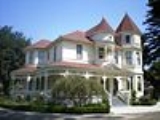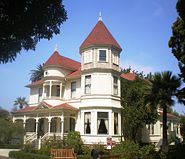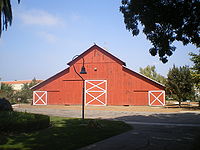
Camarillo Ranch House
Encyclopedia
Camarillo Ranch House, also known as Rancho Calleguas and Adolfo Camarillo House, is a Queen Anne-style Victorian house
in Camarillo, California
. Built in 1892, the 6000 square feet (557.4 m²) house was designed by architects Herman Anlauf and Franklin Ward. It was added to the National Register of Historic Places
in 2003. The house is currently operated by the Rancho Camarillo Foundation and is open to the public for docent-led tours on Saturdays and Sundays. It is also available to be rented for weddings and other special events.
in 1854, becoming the fourth European family in the town. In 1876, Juan Camarillo bought the 10000 acres (40.5 km²) Rancho Calleguas
in eastern Ventura County from Jose Pedro Ruiz for $3,000 in gold. Rancho Calleguas remained in the Camarillo family until the 1960s, eventually becoming the City of Camarillo—named for the family.
and Juan, Jr.
Following her death, the Camarillo daughters (who were bequeathed $5 each in the will) challenged the deeds and the will. The Los Angeles Times reported that it promised to be "the greatest legal battle yet fought" in the courts of Ventura County, as the family members fought over property then valued at "a million dollars or more." While the initial suit was settled within a few months, the sisters filed a new legal action in 1905, alleging that the brothers had deceived their mother and that Juan had confessed his fraud to his sister and paid her $8500. It was also alleged that Adolfo had forced Juan to leave the country upon threats of exposure of his "private acts" that would cause disgrace and scandal. The Los Angeles Times followed the "spicy" case closely, noting that its charges and counter-charges "would furnish material for a sure-enough 'season's best seller.'" At the trial, a letter was introduced purporting to be signed by Martina Camarillo instructing Adolfo to destroy the will leaving everything to himself and his brother. Juan testified that his sister sought to blackmail him by threatening to send him to prison for "an infamous crime," and a grandson testified that he saw Adolfo "mysteriously place a paper in Mrs. Camarillo's tin box within a few minutes after her death."
 In 1892, after receiving title to the Rancho from his mother in 1891, Adolfo Camarillo hired architects Herman Anlauf and Franklin Ward to build a 6000 square feet (557.4 m²) Queen-Anne style Victorian house. The house has two turrets, a large veranda and sprawling lawns. Adolfo also planted many varieties of trees, including eucalyptus trees, around the house. The Camarillo Ranch House, as it is now known, became the center of the sprawling Rancho Calleguas for the next 70 years. From the ranch house, Adolfo oversaw the Rancho's production of lima beans, walnuts, and citrus. The house also became known for the barbecues, rodeos and fiestas held by Adolfo. Adolfo lived in the three-story Victorian mansion until shortly before his death from pneumonia in December 1958.
In 1892, after receiving title to the Rancho from his mother in 1891, Adolfo Camarillo hired architects Herman Anlauf and Franklin Ward to build a 6000 square feet (557.4 m²) Queen-Anne style Victorian house. The house has two turrets, a large veranda and sprawling lawns. Adolfo also planted many varieties of trees, including eucalyptus trees, around the house. The Camarillo Ranch House, as it is now known, became the center of the sprawling Rancho Calleguas for the next 70 years. From the ranch house, Adolfo oversaw the Rancho's production of lima beans, walnuts, and citrus. The house also became known for the barbecues, rodeos and fiestas held by Adolfo. Adolfo lived in the three-story Victorian mansion until shortly before his death from pneumonia in December 1958.
 From the 1920s through the 1960s, the Camarillo Ranch House was most widely known for the white Arabian parade stallions bred by Adolfo. Adolfo rode one of his white Arabians each year in the Fiesta of Santa Barbara dressed in colorful Spanish costume. Even after Adolfo died in 1958, the family continued to carry on the tradition of breeding the white Arabians and riding them in area parades. Adolfo's original sire, Sultan, was a pure white, part Arabian and Morgan stallion. Sultan reportedly produced "snow white, pink skinned foals" no matter the color of the mares with whom he was mated. In 1967, the Camarillos were still breeding the white horses on the remaining 117 acre (0.47348262 km²) owned by the family, and the Los Angeles Times published a feature story on the Camarillo horses. At that time, there were about a dozen Camarillo white Arabians remaining, and the Times wrote: "The Camarillo horses love a parade. Any spectator who has ever watched one dance down the street -- a brightly costumed member of the Camarillo family astride a heavily ornamented silver saddle -- can attest to the predilection." Since the 1920s, the Camarillo horses have appeared in numerous parades and at the opening of the San Francisco-Oakland Bay Bridge in 1941. In 1950, the Camarillo horses led the Rose Parade and have been in many Rose Parades since.
From the 1920s through the 1960s, the Camarillo Ranch House was most widely known for the white Arabian parade stallions bred by Adolfo. Adolfo rode one of his white Arabians each year in the Fiesta of Santa Barbara dressed in colorful Spanish costume. Even after Adolfo died in 1958, the family continued to carry on the tradition of breeding the white Arabians and riding them in area parades. Adolfo's original sire, Sultan, was a pure white, part Arabian and Morgan stallion. Sultan reportedly produced "snow white, pink skinned foals" no matter the color of the mares with whom he was mated. In 1967, the Camarillos were still breeding the white horses on the remaining 117 acre (0.47348262 km²) owned by the family, and the Los Angeles Times published a feature story on the Camarillo horses. At that time, there were about a dozen Camarillo white Arabians remaining, and the Times wrote: "The Camarillo horses love a parade. Any spectator who has ever watched one dance down the street -- a brightly costumed member of the Camarillo family astride a heavily ornamented silver saddle -- can attest to the predilection." Since the 1920s, the Camarillo horses have appeared in numerous parades and at the opening of the San Francisco-Oakland Bay Bridge in 1941. In 1950, the Camarillo horses led the Rose Parade and have been in many Rose Parades since.
Camarillo Ranch House is a popular location not only for weddings and receptions but also for filming. One location manager noted that the house has the appearance of a rural setting "almost anywhere in the United States -- from Bakersfield to Nebraska."
Victorian house
In the United Kingdom, and former British colonies, a Victorian house generally means any house built during the reign of Queen Victoria...
in Camarillo, California
Camarillo, California
Camarillo is a city in Ventura County, California, United States. The population was 65,201 at the 2010 census, up from 57,084 at the 2000 census. The Ventura Freeway Camarillo is a city in Ventura County, California, United States. The population was 65,201 at the 2010 census, up from 57,084 at...
. Built in 1892, the 6000 square feet (557.4 m²) house was designed by architects Herman Anlauf and Franklin Ward. It was added to the National Register of Historic Places
National Register of Historic Places
The National Register of Historic Places is the United States government's official list of districts, sites, buildings, structures, and objects deemed worthy of preservation...
in 2003. The house is currently operated by the Rancho Camarillo Foundation and is open to the public for docent-led tours on Saturdays and Sundays. It is also available to be rented for weddings and other special events.
Juan and Martina Camarillo
Juan and Martina Camarillo were married in 1840 and moved to Ventura, CaliforniaVentura, California
Ventura is the county seat of Ventura County, California, United States, incorporated in 1866. The population was 106,433 at the 2010 census, up from 100,916 at the 2000 census. Ventura is accessible via U.S...
in 1854, becoming the fourth European family in the town. In 1876, Juan Camarillo bought the 10000 acres (40.5 km²) Rancho Calleguas
Rancho Calleguas
Rancho Calleguas was a Mexican land grant in present day Ventura County, California given in 1837 by Governor Juan Alvarado to José Pedro Ruiz. The grant was south of Rancho Las Posas, and east of Rancho El Rio de Santa Clara o la Colonia, north of the Rancho Guadalasca, and west of Rancho El...
in eastern Ventura County from Jose Pedro Ruiz for $3,000 in gold. Rancho Calleguas remained in the Camarillo family until the 1960s, eventually becoming the City of Camarillo—named for the family.
Legal battles for control of the Rancho
Juan Camarillo died in 1880, and Martina Camarillo in 1898. In 1891, Martina had deeded the Rancho to her sons, AdolfoAdolfo Camarillo
Adolfo Camarillo, was a prominent land owner, horse breeder, rancher, and philanthropist in the late 19th and early 20th centuries in Ventura County area of California, U.S.A. Adolfo, along with his brother Juan, Jr., owned much of what later became the town known by their family name, Camarillo...
and Juan, Jr.
Juan Camarillo, Jr.
Juan E. Camarillo, Jr. was a wealthy landowner and philanthropist in Ventura County, California, United States. Juan and his younger brother Adolfo Camarillo lived in Casa Camarillo, and were involved in the mercantile business...
Following her death, the Camarillo daughters (who were bequeathed $5 each in the will) challenged the deeds and the will. The Los Angeles Times reported that it promised to be "the greatest legal battle yet fought" in the courts of Ventura County, as the family members fought over property then valued at "a million dollars or more." While the initial suit was settled within a few months, the sisters filed a new legal action in 1905, alleging that the brothers had deceived their mother and that Juan had confessed his fraud to his sister and paid her $8500. It was also alleged that Adolfo had forced Juan to leave the country upon threats of exposure of his "private acts" that would cause disgrace and scandal. The Los Angeles Times followed the "spicy" case closely, noting that its charges and counter-charges "would furnish material for a sure-enough 'season's best seller.'" At the trial, a letter was introduced purporting to be signed by Martina Camarillo instructing Adolfo to destroy the will leaving everything to himself and his brother. Juan testified that his sister sought to blackmail him by threatening to send him to prison for "an infamous crime," and a grandson testified that he saw Adolfo "mysteriously place a paper in Mrs. Camarillo's tin box within a few minutes after her death."
Adolfo Z. Camarillo
Eventually, Adolfo Z. Camarillo (1864–1958) came to control the rancho and turned it into "the largest bean ranch in the world." Camarillo employed 700 workers on his ranch, and his production was so great that the Los Angeles Times reported in 1909 that, "through the enormous output of his ranch, [Camarillo] is, in a measure, able to set the price which the public must pay for beans." Adolfo Camarillo became one of the wealthiest landowners in the county, and in 1911 he was elected chairman of the Ventura County Board of Supervisors. He also served as a member of the State Board of Agriculture.Architecture and use as the center of ranch operations

Camarillo Ranch's white Arabian stallions

Sale and subdivision of the Rancho
In 1963, the family put the vast ranch property up for sale. An initial sale of 5500 acres (22.3 km²) in 1963 fell through, but the ranch was eventually sold off and its vast ranch lands developed into the housing tracts and commercial and industrial centers of modern Camarillo. The Camarillo family retained about 100 acre (0.404686 km²), including the old ranch house.Recent use of the Ranch house
In 1998, the Camarillo Planning Commission approved a zoning change to allow an industrial park to be built around the Camarillo Ranch House, but conditioned the approval on the developer's donating the ranch house, barn and 4.4 acres (17,806.2 m²) to the city. The city then renovated the house and opened it to the public in 2001 as a museum and site for receptions and other functions. The house is operated by the nonprofit Camarillo Ranch Foundation. The renovation cost $1.5 million and was also made possible by volunteers who donated 10,000 hours to the effort.Camarillo Ranch House is a popular location not only for weddings and receptions but also for filming. One location manager noted that the house has the appearance of a rural setting "almost anywhere in the United States -- from Bakersfield to Nebraska."

